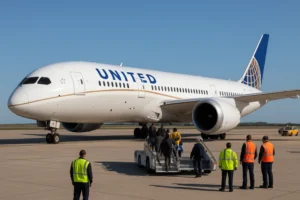Although air travel is among the safest ways to journey, even the most advanced aircraft can occasionally face unexpected challenges.. Recently, headlines around the world focused on the United Airlines Flight UA770 emergency diversion, where the aircraft was forced to change its course mid-air and land at an alternate airport.
For many passengers, the words “emergency diversion” can spark fear. However, in aviation, diversions are not signs of disaster — they are signs of safety protocols working exactly as intended. In the case of United Airlines Flight UA770, the crew responded swiftly, made the right decisions, and ensured the safe landing of all passengers and crew..
In this article, we’ll take a deep look into the story of Flight UA770: what happened, why it happened, how the crew and passengers handled it, and what lessons can be learned from this real-life aviation event.
The Incident: What Unfolded Aboard Flight UA770?
Flight Details
United Airlines Flight UA770 was operating as an international long-haul route. Reports suggest it was traveling from Barcelona to Chicago aboard a Boeing 787 Dreamliner, one of United’s flagship long-haul aircraft.
The Dreamliner is known for its fuel efficiency, advanced pressurization system, and passenger comfort features. But like any machine, it requires constant monitoring.
Mid-Air Emergency Declaration
Midway through the journey, the pilots noticed an anomaly in the cabin pressurization system. Although passengers may not have noticed anything unusual at first, pilots in the cockpit rely on highly sensitive instruments that detect even the smallest deviations.
To ensure safety, the crew decided to declare an emergency. They transmitted the transponder code 7700, which is universally recognized in aviation as a general emergency signal.
This action immediately alerted air traffic control (ATC) and gave Flight UA770 top priority over all other traffic.
Emergency Diversion to London Heathrow

The flight crew, in consultation with ATC, determined that London Heathrow Airport was the best diversion option. Heathrow is one of the world’s busiest airports, equipped with advanced emergency services, long runways suitable for the Boeing 787, and medical facilities.
The aircraft touched down safely without any additional issues. Emergency services were on standby, but fortunately, they were not needed as no passengers or crew members were injured.
What Caused United Airlines Flight UA770 to Divert?
Aircraft Pressurization Systems and Passenger Safety
The suspected cause was a cabin pressurization irregularity. At cruising altitudes of 35,000 feet, cabin pressure must be carefully maintained. If it drops, passengers and crew could experience hypoxia (oxygen deprivation).
While not every pressurization anomaly leads to a dangerous situation, aviation safety standards demand caution. If there is any doubt about the integrity of the system, the aircraft must descend or divert.
Why Declaring an Emergency Matters
Declaring an emergency (Squawk 7700) may sound alarming, but it is standard protocol. It doesn’t always mean the aircraft is in immediate danger. Instead, it means:
- The crew wants priority landing clearance.
- ATC and ground services should prepare emergency support.
- Other aircraft must yield priority in the airspace.
This precaution ensures a safe, rapid response if the situation worsens.
Choosing the Right Airport
Heathrow was chosen because of:
- Runway length suitable for a wide-body aircraft.
- Proximity to the flight’s position.
- Emergency infrastructure including fire, rescue, and medical units.
- United Airlines presence, making passenger support easier.
The Crew’s Swift and Professional Response
Pilots: Calm Decision-Making
The pilots of Flight UA770 followed strict protocols. Their decision-making process likely included:
- Identifying the Cause of the Issue
- Running through emergency checklists.
- Communicating with ATC.
- Declaring emergency status.
- Coordinating diversion plans.
This is a textbook example of how training prepares crews for unexpected events.
Cabin Crew Role
While pilots focused on the technical side, cabin crew managed the passenger experience. They would have:
- Secured the cabin.
- Reassured passengers with calm communication.
- Monitored passenger well-being.
- Prepared for potential rapid descent (if needed).
Safe and Smooth Landing at Heathrow
Upon arrival, passengers reported a safe, uneventful landing. Emergency vehicles followed the aircraft to the gate as a precaution. The professionalism of the entire crew minimized stress for passengers.
Passenger Experience Aboard Flight UA770
Initial Reactions
Hearing the word “emergency” while flying can trigger anxiety. Some passengers likely felt uneasy, while others may not have noticed anything unusual until announcements were made.
The Importance of Clear Communication
Open and transparent communication is essential.. The crew explained that while an issue had been detected, the decision to divert was purely precautionary. This helped maintain calm in the cabin.
Relief and Aftermath
Once safely on the ground, passengers expressed relief. While diversions can be inconvenient, most agreed that safety comes first. United Airlines arranged rebooking, accommodation, and support for onward travel.
What Are the Common Reasons Flights Get Diverted?
Flight diversions are relatively rare, but they happen for several reasons:
Mechanical Issues
Problems like hydraulic faults, electrical issues, engine warnings, or pressurization anomalies often lead to diversions.
Medical Emergencies
If a passenger suffers a medical emergency, the crew may divert to the nearest airport with proper medical facilities.
Severe Weather
Thunderstorms, snowstorms, or strong winds can make an airport unsafe, requiring diversions.
Security Concerns
Although uncommon, security threats can also force diversions.
Operational Issues
Examples include fuel miscalculations, crew duty limits, or airport closures.
Aviation Safety Measures in Action
The UA770 diversion highlights how aviation safety systems protect passengers. Key protocols include:
- Early detection: Aircraft systems detect irregularities instantly.
- Redundancy: Backup systems ensure safety even if one system falters.
- Emergency training: Pilots undergo continuous simulator training for emergencies.
- Ground coordination: ATC and airports are always ready to handle emergencies.
This multi-layered safety system helps make commercial aviation among the safest industries worldwide.
Comparisons: Other Notable Diversions
The UA770 diversion isn’t the first of its kind. Similar events have occurred:
- British Airways BA286 – A Dreamliner diverted due to pressurization issues.
- Delta Flight DL89 – Diverted to Los Angeles after an engine anomaly.
- Emirates EK203 – Diverted for a passenger medical emergency.
In each case, diversions were precautionary and successful, showing that safety protocols consistently work.
Lessons Travelers Can Learn from UA770
- Stay calm: Diversions are part of aviation safety.
- Trust the crew: Pilots and cabin staff are highly trained.
- Expect delays: Your journey may take longer, but your safety is the priority.
- Prepare for the unexpected: Always keep essentials (medication, charger, important documents) in your carry-on.
FAQs
1: What Was the Reason Behind United Airlines Flight UA770’s Emergency Diversion?
A suspected cabin pressurization issue forced United Airlines Flight UA770 to make a precautionary diversion, ensuring passenger safety and comfort.
2: Were any passengers injured?
All passengers and crew of United Airlines Flight UA770 landed safely after a precautionary diversion caused by suspected cabin pressurization issues.
3: What Is the Meaning of Squawk 7700 in Aviation?
The universal emergency transponder code is used to alert Air Traffic Control (ATC) about critical in-flight situations requiring immediate attention.
4: Why was Heathrow chosen?
The flight diverted to the nearest major airport equipped with the proper facilities to handle the aircraft safely and efficiently.
5: What happens after a flight diversion?
After landing, the aircraft undergoes inspection, passengers are rebooked on alternate flights, and investigations confirm the exact cause.
Conclusion
The United Airlines Flight UA770 emergency diversion is a powerful reminder of why aviation is considered so safe. While the words “emergency” and “diversion” may sound alarming, they actually reflect the strength of safety protocols. Thanks to quick action by pilots, professionalism from the cabin crew, and the readiness of Heathrow Airport, the incident ended safely and smoothly. For travelers, the key takeaway is clear: when diversions happen, it means the system is working exactly as thoughtfully engineered to guarantee your safety.




